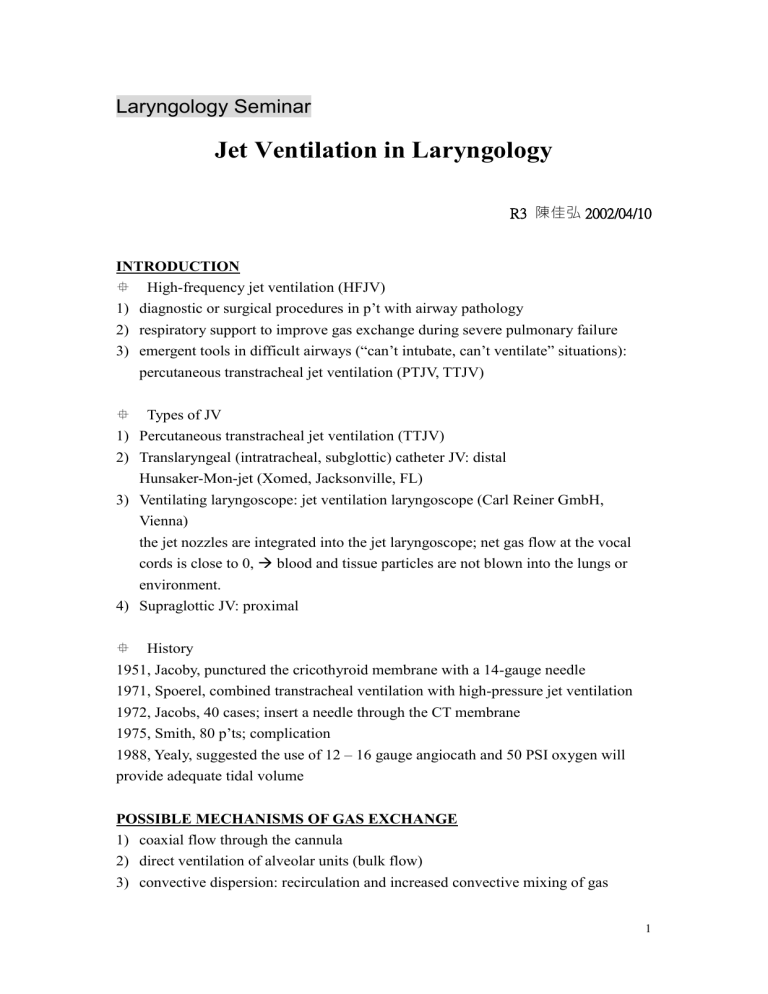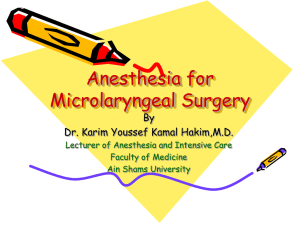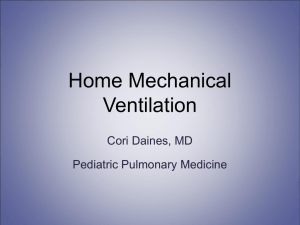percutaneous transtracheal jet ventilation

Laryngology Seminar
Jet Ventilation in Laryngology
R3
陳佳弘
2002/04/10
INTRODUCTION
High-frequency jet ventilation (HFJV)
1) diagnostic or surgical procedures in p’t with airway pathology
2) respiratory support to improve gas exchange during severe pulmonary failure
3) emergent tools in difficult airways (“can’t intubate, can’t ventilate” situations): percutaneous transtracheal jet ventilation (PTJV, TTJV)
Types of JV
1) Percutaneous transtracheal jet ventilation (TTJV)
2) Translaryngeal (intratracheal, subglottic) catheter JV: distal
Hunsaker-Mon-jet (Xomed, Jacksonville, FL)
3) Ventilating laryngoscope: jet ventilation laryngoscope (Carl Reiner GmbH,
Vienna) the jet nozzles are integrated into the jet laryngoscope; net gas flow at the vocal cords is close to 0,
blood and tissue particles are not blown into the lungs or environment.
4) Supraglottic JV: proximal
History
1951, Jacoby, punctured the cricothyroid membrane with a 14-gauge needle
1971, Spoerel, combined transtracheal ventilation with high-pressure jet ventilation
1972, Jacobs, 40 cases; insert a needle through the CT membrane
1975, Smith, 80 p’ts; complication
1988, Yealy, suggested the use of 12 – 16 gauge angiocath and 50 PSI oxygen will provide adequate tidal volume
POSSIBLE MECHANISMS OF GAS EXCHANGE
1) coaxial flow through the cannula
2) direct ventilation of alveolar units (bulk flow)
3) convective dispersion: recirculation and increased convective mixing of gas
1
within conducting airways
“Pendelluft”: differences in recoils among different regions of the lungs.
4) facilitated diffusion (Taylor): asymmetrical velocity profiles during inspiration and expiration
augmented diffusion of gas in the large and medium sized airways.
5) molecular diffusion: in the more distal air spaces near the alveolo-capillary membrane; bulk flow cannot penetrate to this level.
6)
Venturi effect: “air entrainment”; depending on the degree of airway patency above the jet;
The percentage of the amount of room air entrainment (
E
) to measured total tidal volume (V
T
):
E
/V
T
(%) = ([respirator F
I
O
2
- tracheal F
I
O
2
] x 100/tracheal F
I
O
2
-
0.21)/(100 + [respirator F
I
O
2
- tracheal F
I
O
2
] x 100/tracheal F
I
O
2
- 0.21)
Expiration: passive secondary to the elastic recoil of the lungs and the chest wall
Combined synchronous inspiration and expiration high pressure (50 lb per sq. inch [PSI], 3.4 atm), respiratory frequencies of 150-900 cycles/minute; small tidal volumes.
Oxygenation: may be difficult in the presence of stenosis, massive bronchial secretion, restrictive lung disease.
CO2 elimination: more effective with superimposed HFJV (Bacher)
1 psi = 0.068 atm;
1 atm = 76 cmHg = 1013.25
毫巴 (millibar)
1,000,000 dyne/cm
2
=1bar
SETTING OF PARAMETERS
Pressure: pounds per inch (PSI)
Flow:
At high pressure (20-50 PSI) and high flow (0.5-1.0 L/ sec)
↑ the tidal volume, ↑ the risk of barotraumas
Lung compliance: 50 mL/cmH2O, a 1-sec inspiratory time and a 50 PSI oxygen
Tidal volume: 600 mL with a 18-gauge i.v. catheter
1200 mL with a 14-gauge catheter
12G, ID 2.8 mm
14G, ID 1.5 mm
16G, ID 1.2 mm
22G, ID 0.8 mm
24G, ID 0.6 mm
6 F, ID 2 mm
50 psi 1600 mL/sec 500 mL/sec
Frequency (respiratory rate):
1) high frequency 400-800/ min
delay expiration of gas; prevent the lungs from
2
being totally exhausted at the end of expiration;
HF jet prevents a complete closure of the vocal cords, and only a slight movement of the peripheral parts of the vocal cords is observed
2) low frequency 8-20/ min
remove CO2; movements of the vocal cords
3) combined frequency 600 & 15/ min
subglottic low-frequency, subglottic combined-frequency, and supraglottic combined-frequency; “double jet”
Inspiratory/expiratory ratio: 1:1.5
INDICATION
1) Elective: direct laryngoscopy, vocal cord surgery, airway surgery
2) Emergency: asphyxia (cannot intubate, cannot ventilate); difficult or failed intubation; examples: foreign bodies, trauma, infection, neoplasm, laryngeal edema; lack of equipment and/or trained personnel for conventional airway management
3) laryngeal edema: incidence following extubation: 4.2%; 1% of patients requiring re-intubation
escape of the high-pressurized air prevented the closure of the glottic aperture; jet of bubbles
guided the bronchoscope to the glottic aperture.
PERCUTANEOUS TRANSTRACHEAL JET VENTILATION
Required Equipment: High-pressure oxygen supply (50 PSI or wall outlet), regulator and supply tubing, jet injector, oxygen tubing, Luer-lock connector, IV catheter (14 or 16 gauge). Specialized, reinforced catheters are less likely to kink after removal of the needle.
Technique: IV catheter is introduced through the cricothyroid membrane, and air is aspirated from a syringe. The catheter is advanced into the trachea and connected to the oxygen tubing using the Luer-lock. Gas flow is controlled using
3
the jet injector. Adequacy of ventilation is judged by listening for breath sounds and observing chest excursion.
Advantages: Rapid institution of ventilation in the patient with a difficult airway if the components are previously assembled. May allow ventilation during fiberoptic ventilation or other airway placement.
Disadvantages: Requires high-pressure gas source. Will not allow complete ventilation from standard anesthesia machine. Depends on patency of the upper airway for ventilation. May cause subcutaneous emphysema, pneumomediastinum, pneumothorax or other types of barotrauma.
Examples of use: Emergency ventilation in the unable to intubate or ventilate by mask setting. Adjunct to provide partial or complete ventilation during use of other technique for management of difficult airway.
Caution: ample time to allow the passive recoil of the lungs (2~3 sec), preventing barotraumas; maintain patency of natural airway as much as possible (maintain jaw trust; insertion of oropharyngeal or nasopharyngeal airway); kinked or displaced catheter (special transtracheal catheter (6F) for PJTV, firm, resist kinking); incoordination of respiratory effort; outlet obstruction (distal secretion)
Adverse Effects: barotraumas, bleeding at the site of insertion, loss of position of the catheter if it is not held firmly during ventilation
Contraindication: distorted anatomy, bleeding diathesis, complete airway obstruction (high pressure
barotrauma); chronic obstructive pulmonary disease, restrictive pulmonary disease, coronary artery disease, and extreme obesity
Complications:
1.
due to improper catheter insertion technique, a kinked catheter, unusual anatomy
catheter misplacement
2.
hemorrhage at the insertion site, perforation of the posterior wall of the trachea, esophageal injury, subcutaneous or mediastinal emphysema, pneumothorax.
1988, Monnier, 65 p’ts laser endoscopic tx of laryngeal/subglottic lesion → one cervicomediastinal empysema due to the dislodgment of the cannula
1976, Smith et al.: 28 patients receiving TTJV in an emergency → 29% complication; subcutaneous emphysema (7.1%), mediastinal emphysema
(3.6%), exhalation difficulty (14.3%), arterial perforation (3.6%)
barotrauma, especially in total airway obstruction.
Warning signs: hypotension, hypoxia, tachycardia during jet ventilation
3.
tracheal mucosa damage(by non-humidified gas)-- an early problem with HFJV
4.
overexpansion--especially as lung compliance improves. frequent CXR; rib expansion < with 8 th
ribs of expansion being the goal.
5.
decreased cardiac output--due to overexpansion and may also occur if excessive
4
rate or max. airway pressure used (does allow for complete exhalation).
6.
airleak
HIGH FREQUENCY JET VENTILATION IN UPPER AIRWAY SURGERY
Good exposure of operating filed
Endoscopy and surgery of the proximal airway
Advantages:
Visibility, accessibility, No ETT ignition during use of LASER, low airway pressure
Disadvantages:
Potential of lung injury (barotrauma), efficacy of gas exchange is less predictable, monitoring of CO2 elimination, inhalational anaesthetics not usable or recommended, gas heating and ↓ humidification
dry mucosa.
JETTING TECHNIQUE for upper airway surgery
IV anaesthesia, muscle paralysis, topical anaethesia, jet ventilation (distal or proximal)
“EXPIRATION MUST BE UNIMPAIRED”
Distal Jetting a. excellent surgical access to the entire larynx and subglottic region b. through the larynx or percutaneously c. minimal movement of vocal cords. d. passed through the subglottic stenosis (4-5 mm)
Proximal Jetting a. attachement to laryngoscope b. malleable metal cannula: length: 13.5 cm; OD 2 or 3 mm c. disadvantages: forceful flow into the lower respiratory tract (tissue debris, blood, other secretions, papilloma, tumor), gas into the stomach
distention
gastric reflux (rare)
5
TUBES IN ANESTHESIA FOR MICROLARYNGEAL SURGERY
1) fluoroplastic tubes: laser-safe, nonflammable subglottic jet ventilation tube a.
did not continue burning when the CO2 laser was turned off in 100% oxygen;.may be damaged by the CO2 laser beam, even when coated by blood; b.
neither the KTP nor Nd-YAG laser damaged the Teflon tube; ignited a sustained flame in 30% oxygen c.
Hunsaker Mon-Jet tube: polytetrafluoroethylene (Xomed, Jacksonville, FL) i.
ID 2.7 mm; OD 4.3 mm; 35.5 cm long ii.
allows monitoring of tracheal pressure and end tidal carbon dioxide, iii.
designed with a basket-shaped distal extension to align the jet port away from the tracheal mucosa and to prevent trauma and submucosal injection of jetted gas
2) Silastic, Red Rubber, and polyvinyl chloride (PVC) tubes: continued to burn in
23% oxygen; no difference in the flammability of Silastic, rubber or PVC a. Benjet tube: polyvinyl chloride (PVC) tube (Tuta Labs, Sydney, Australia)
ID1 mm; OD 2.8 mm; 35 cm long; 6 to 8 cm below the glottis (unobtrusive for the surgeon); 4 plastic petals (preventing potential traumatic whipping effect)
RISK FACTORS WHICH INCREASE IGNITION
Inflammable material; FiO2> 50%; high laser power; extended exposure time with laser firing (continuous pulsation > 20 sec); failure to moisten the cotton gauze pads
REFERENCE:
1.
Benumof JL, Scheller MS.The importance of transtracheal jet ventilation in the
6
management of the difficult airway. Anesthesiology 1989 Nov;71(5):769-7.
Comment in: Anesthesiology. 1990 Apr;72(4):773-4. Anesthesiology. 1990
Oct;73(4):787-8. Anesthesiology. 1990 Oct;73(4):788.
2.
Patel, R. Use of Percutaneous Transtracheal Jet Ventilation (PTJV) during
Difficult Airway Management. The Internet Journal of Emergency and Intensive
Care Medicine 1999 Vol3N1:
3.
Ihra G, Gockner G, Kashanipour A, Aloy A. High-frequency jet ventilation in
European and North American institutions: developments and clinical practice.
Eur J Anaesthesiol. 2000 Jul;17(7):418-30.
4.
Ihra G, Aloy A. On the use of Venturi's principle to describe entrainment during jet ventilation. J Clin Anesth. 2000 Aug;12(5):417-9.
5.
Bacher A, Lang T, Weber J, Aloy A. Respiratory efficacy of subglottic low-frequency, subglottic combined-frequency, and supraglottic combined-frequency jet ventilation during microlaryngeal surgery.
Anesth Analg. 2000 Dec;91(6):1506-12.
6.
Patel RG. Percutaneous transtracheal jet ventilation: a safe, quick, and temporary way to provide oxygenation and ventilation when conventional methods are unsuccessful. Chest. 1999 Dec;116(6):1689-94.
7.
Hautmann H, Gamarra F, Henke M, Diehm S, Huber RM. High frequency jet ventilation in interventional fiberoptic bronchoscopy. Anesth Analg. 2000
Jun;90(6):1436-40.
8.
Monnier PH, Ravussin P, Savay M, et al: Percutaneous transtracheal ventilation for laser endoscopic treatment of laryngeal and subglottic lesion. Clin Otholargo
1988;13:209-217.
9.
Hunsaker DH. Anesthesia for microlaryngeal surgery: the case for subglottic jet ventilation. Laryngoscope 1994 Aug;104(8 Pt 2 Suppl 65):1-30.
10.
Brooker CR, Hunsaker DH, Zimmerman AA. A new anesthetic system for microlaryngeal surgery. Otolaryngol Head Neck Surg 1998 Jan;118(1):55-60.
11.
Santos P, Ayuso A, Luis M, Martinez G, Sala X. Airway ignition during CO2 laser laryngeal surgery and high frequency jet ventilation. Eur J Anaesthesiol. 2000
Mar;17(3):204-7.
12.
Jacoby JJ, Hamelberg W, Ziegler CH, et al: Transtracheal resuscitation. JAMA
1956; 162:625-628.
13.
Spoerel WE, Narayanan PS, Singh NP: Transtracheal ventilation. Br J Anaesth
1971;43:932-939.
14.
Yealy DM, Stewart RD, Kaplan RM: Myths and pitfall emergency translaryngeal ventilation: Correcting misimpressions. Ann Emerg Med 1988;17:690-692.
15.
Giunta F, Chiaranda M, Manani G, Giron GP. Clinical uses of high frequency jet
7
ventilation in anaesthesia. Br J Anaesth. 1989;63(7 Suppl 1):102S-106S.
16.
Lanzenberger-Schragl E, Donner A, Grasl MC, Zimpfer M, Aloy A. Superimposed high-frequency jet ventilation for laryngeal and tracheal surgery. Arch Otolaryngol
Head Neck Surg. 2000 Jan;126(1):40-4.
8








